Features of planting tulips in autumn

Tulips are one of the earliest flowers. Recently, many varieties have appeared, so they began to enjoy particular success with gardeners. In order to please yourself with a fresh bouquet in the spring, you need to plant the flower correctly in the fall.



Landing dates
The landing time in the Moscow region, in the Urals and in Siberia will differ. Most often, experienced plant breeders practice planting tulips after the first snowfall, and this is approximately the end of November - early December, in colder regions it can be planted in October. In this case, immediately after planting, it is necessary to try to cover the area with dry leaves, which will provide reliable protection to the bulbs during the first frost.
Autumn planting should not be done early in the season - this is not the right time, regardless of the region. Haste often leads to the death of the bulbs after the first frost. Planting bulbs later than the due date is also not worth it, since they will not have time to hatch, respectively, this can also lead to the death of plants.
Correct planting of tulip tubers involves measuring soil temperature. At a depth of 150 mm, it should be at + 10 C or higher, but not lower.
You should not be guided only by the calendar, experienced gardeners periodically measure the temperature of the soil with the onset of the season, which allows you to establish the most favorable planting day for the plant. In this case, it is almost impossible to make a mistake.

Small bulbs should be planted along the edge of the plot, large ones in the center.
If the planting is carried out in accordance with the advice of specialists and their recommendations, then in early spring, colorful tulips begin to bloom in the flowerbed in a wide variety.
Growers give their advice in this direction.
- It is worth planting tulip bulbs in the fall 6–8 weeks before a severe frost. It is usually September or October in the north and November or December in the south.
- When buying bulbs, they are not stored, but placed in the ground as soon as possible.
- In southern climates with mild winters, bulbs are planted at the end of November - December. The bulbs must be refrigerated for about 12 weeks before planting. Planting stock suppliers often offer pre-chilled bulbs.

Seat selection
It is important for flowers where they grow: the productivity of the flower garden depends on this. It is advised to select a flat and well-lit area where groundwater does not flow close to the surface. Practice has shown that when using uneven areas after long-term rains, moisture accumulates in the pits, as a result - rotten tulip tubers or frozen ones. If the shady part of the plot is used for planting, the stems will curl, and the color of the bud will slightly change the natural shade, that is, it will become paler.
Do not plant material in soil that has a high acidity level, as this plant prefers soil with a neutral pH or slightly alkaline. Soil preparation should begin several months before planting. All you need to do is add fertilizer and dig up the soil.


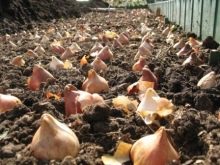
What to rely on when choosing.
- Tulips prefer areas with a lot of sun. In regions with high temperatures in spring and early summer, you can stay in a shady place where the sun only appears in the morning.
- The soil should be well-drained, neutral or slightly acidic, fertile, dry or sandy.All tulip varieties do not like areas with excessive moisture.
- Higher varieties must be protected from strong winds.
- Leave a gap of 4 centimeters between the bulbs.
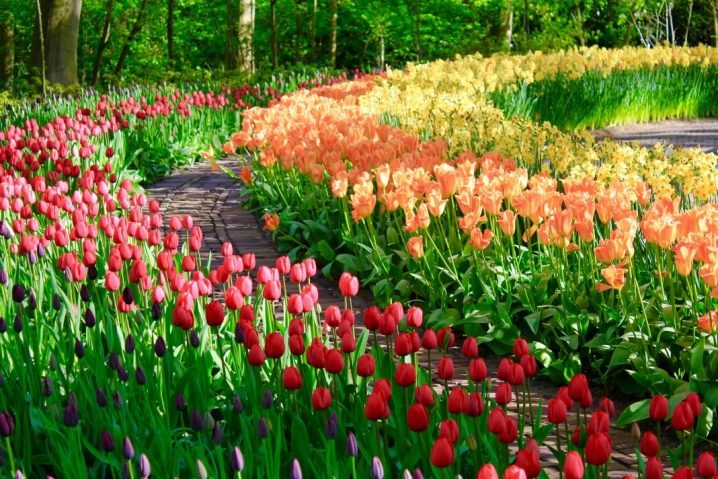
Preparation
Tulips can grow in flower beds for 3-4 years without transplanting. However, they should be changed annually or every two years if the bulbs are grown to sell flowers or planting material. In addition, replanting annually helps to avoid fungal diseases, since the bulbs are harvested every year, and the diseased are then discarded.
Most tulip growers plant the bulbs in flower beds 1-1.2 meters wide for convenience. If the water level in the area is high, tulips are best planted in raised beds, that is, 20-25 cm above the soil level.

The soil
The soil must be well prepared before planting the bulbs. It needs not only to be plowed, but also to remove the roots of weeds and fertilize. They dig and loosen the soil deeply. The porous soil improves the flow of oxygen and nutrients to the plant roots.
Experienced growers advise to mix the soil with compost, peat moss; level the surface. For planting tulip bulbs, small holes are dug about 10 centimeters deep. Place the bulb inside with the wide base down, and the pointed end up.


Bulbs need moisture to grow normally, but excess water will provoke rot so they will never germinate. Winter tulip care includes the use of a light mulch cover and very discreet watering. The mulch will keep the soil warm and moist enough. Mulching with a 25 cm layer of sawdust, peat or compost is absolutely necessary in this case. The root of the bulb should take three weeks to take root.
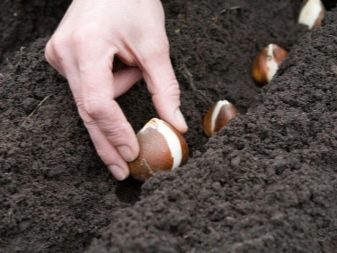
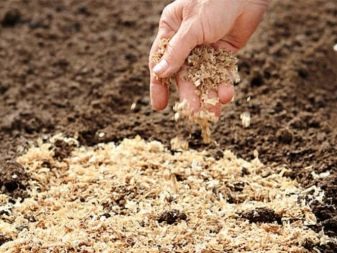
Bulbs
Bulbs bought in the fall already have a flower embryo hidden inside. He is just waiting to start growing in the spring. If the planting material is purchased in late August or early September, then you will have to wait to plant them in October - November. Tulips grow so quickly that if planted immediately after purchase, they will immediately release their leaves. Therefore, it is required to store the bulbs in paper bags, and not in plastic containers, in a cool place: basement, cellar or the bottom shelf of the refrigerator.
Do not put bulbs next to apples. They, like bananas, release ethylene gas, which helps ripen, but kills the flower bud inside any bulb. If there is no room in the fridge, you cannot put them in the freezer - this will kill them.
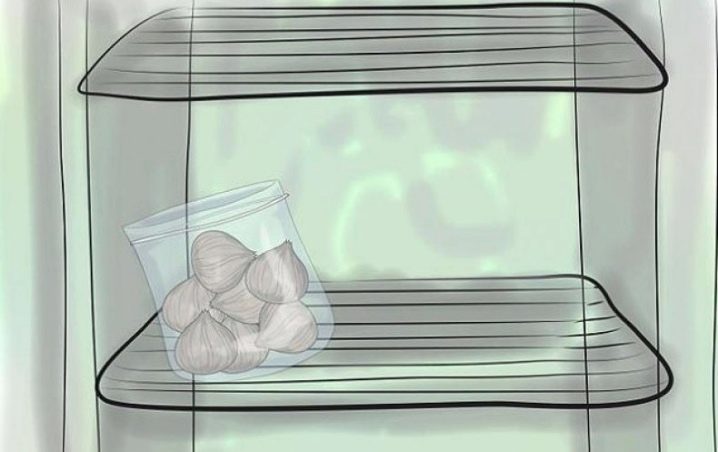
Before planting tulip tubers, you need to carefully select those that will not give healthy offspring in the future. Healthy, intact tubers without visible damage are laid on a separate side for planting. It is advisable to treat them with potassium permanganate or use a specialized preparation for fungi, which is sold in the store.
Choose healthy planting material of impressive size, without cracks, signs of rot or black fungal mold on the outside. The bulbs must be firm. Damaged, sick or soft ones are removed. Be sure to sort the material by size, grade and color.
Never throw discarded bulbs into the compost heap.
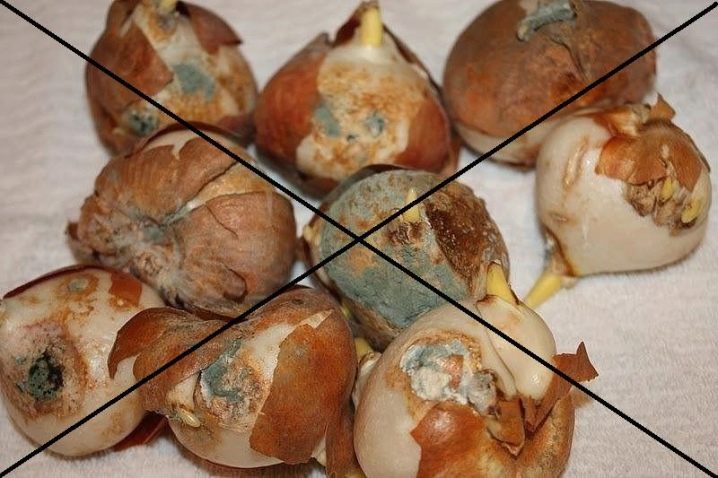
Before planting, tulips are soaked for 30-60 minutes in 0.5% potassium permanganate solution. After the procedure, the bulbs are immediately planted in the soil prepared in advance. The planting material will quickly absorb water, its lower part will swell and a good root system will soon appear.

Step-by-step instruction
There is nothing difficult in planting tulips in the fall. First, they dig up and level the top layer of soil, which is called fertile. This should be done at a depth of 35o mm. At the second stage, mineral fertilizing is introduced, wood ash is very suitable for maintaining a young plant.Only after that, the flower is planted to a depth of 15 cm; for greater comfort between the tubers, it is imperative to keep a free space of 100 mm.
There are many rules that characterize the correct planting of a flower in a summer cottage in the open field. A general rule of thumb is to plant the bulbs at a depth equal to the size of 3 bulbs if planting in well-drained soil, and 2 if in heavy soil, but no deeper than 20 cm.


Large heads should be placed in the ground at a distance of 8 to 12 cm and with a row spacing of 20–25 cm. Small bulbs planted in rows are spaced 5 cm apart and with a row spacing of 15 cm. If planted too tightly , tulips will produce very little planting material for the next year ..

You cannot push tulips into the soil with your fingers - it is much better to first make a row, place the bulbs in it and carefully cover it with soil. If pressed too hard, the heads are injured and become vulnerable to disease. Bulb planting tools are easy to obtain from specialized garden centers.
Experienced gardeners recommend planting tulips in flower beds with sand, the layer of which should be 3-5 cm: this material provides lightness to the soil, and moisture evaporates faster, due to which putrefactive processes do not develop. In this version, the bulbs are slightly immersed in sand, then covered with a thin layer and then covered with soil. It is a proven fact that flowers in such soil grow healthy, and the bulbs are less prone to rotting, since excessive moisture freely leaves. This is a useful method for growing rare and expensive tulips.
To scare off mice and moles, coniferous branches are placed in the planting holes, rubble or even cat droppings can be laid out.


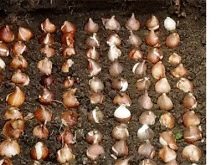
Care
Tulips flower best when planted in the fall months before the first frost. After the flower requires little maintenance. In early spring, remove all mulch and allow the soil to absorb sunlight. Very light loosening around tulips is recommended to remove weeds, if any.
A small amount of fertilizer should be applied so that it mixes with the soil to a depth of 2 cm. When it rains or is watering, the fertilizing dissolves in the soil and reaches the tuber, thereby helping it germinate on time.
For the development of a flower, it is best to use fertilizing with a high content of phosphorus, nitrogen mixtures are added during planting, then they are no longer used, since their excess leads to the build-up of a large amount of green mass, but the depletion of the tuber.



Fresh manure, no matter how attractive it looks, will cause rot. It is better to use wood ash in the amount of 200 grams per square meter of sown area or 0.5 kg of dolomite flour. Tulips are very fond of double superphosphate - it is enough for the indicated area of 50 grams or 30 grams of potassium sulfate. Urea and ammonium nitrate are the most commonly used nitrogen fertilizers.
In the event that top dressing was not introduced into the soil during digging, then immediately before planting, nitrophoska is used, in an amount of 0.10 kg per square meter.




At this time, it will be necessary to saturate the soil with water-soluble fertilizers, which are specifically designed to activate growth. Healthy first leaves are a sign of future healthy flowering. As soon as tulips begin to bloom, it's time to watch for the appearance of parasites, especially aphids.
This small insect is very fond of the flower. It can damage not only the buds, but the entire plant, including the bulbs.
In this case, germicide treatment will be the most effective remedy.

Once the flowering season is over, leave the bulbs in the ground or use one of the storage methods to ensure good growth the next season.
Experienced growers give their advice on tulip care.
- If it rains weekly, then additional watering is not performed. However, if a period of drought comes, then the soil is moistened every week until the first frost hits.
- Rainy summers, irrigation systems and moist soil are deadly to tulips. Crushed pine bark, sand or any other coarse material is specially added to the soil in order to make high-quality drainage in the open field.
- It is imperative to apply compost annually to provide the soil with nutrients for future flowering.
- In the spring, when the first leaves appear, you need to feed the planting with bone meal.
- The foliage should remain on the plants for about 6 weeks after flowering. It is necessary so that the flower can collect energy for flowering next year. After the foliage turns yellow and withers away, it can be trimmed.
- Larger varieties may need replanting every few years, while smaller varieties tend to reproduce on their own.


Possible mistakes
Novice growers do not deliberately make mistakes when planting tulip bulbs. Most often this happens due to a lack of knowledge and experience. Does the plant suffer from this? Yes, like the florist himself, who ends up getting a smaller harvest than he expected.
You can minimize losses if you know about the most common mistakes.
- Disembarkation is either too early or late.
- Before planting, the seed is not taken - as a result, diseased or damaged bulbs are immersed in the soil, which after a while not only rot, but also infect new plants.
- The tubers sink too deep into the soil or, conversely, remain too close to the surface of the earth. In the first case, the bulb wakes up much later, in the second, it freezes at the first frost.
If you did not have time with planting, then it is worth carrying out the procedure in early spring, when the sun is already quite active, and the earth has warmed up well. This option for late gardeners is available not only in the southern regions, but also in the northern ones, only you need to calculate the time correctly.


Tulips planted deeper in the soil will bloom longer and add color and life to the flower bed at the end of the season. It is worth considering using several different varieties. You can plant bulbs in various places around your yard, such as a large flower garden in the middle of your lawn.
A month and a half after cutting the flowers, the bulbs are removed and "canned" in a cool, dry place. You can pre-treat with a manganese solution, but after that each tuber must be dried well. It should not be forgotten that high temperatures can spoil the bulb or lead to poor quality in new plants.
Tulips are flowers that can grow in almost any soil, but loose ones are best. You can plant in loam, but it should have a slightly alkaline or neutral pH. In any case, even if peat or sand is added to the soil, the planting site must be changed every four years.
If the grower follows the advice of professionals, then in the spring he will be able to harvest a rich crop of tulips or simply enjoy the colorful landscape in the flower bed. The main thing is to choose the right time for planting tubers, otherwise they will be irretrievably damaged.

You will learn more about planting tulips in autumn in the following video.







































































































The comment was sent successfully.